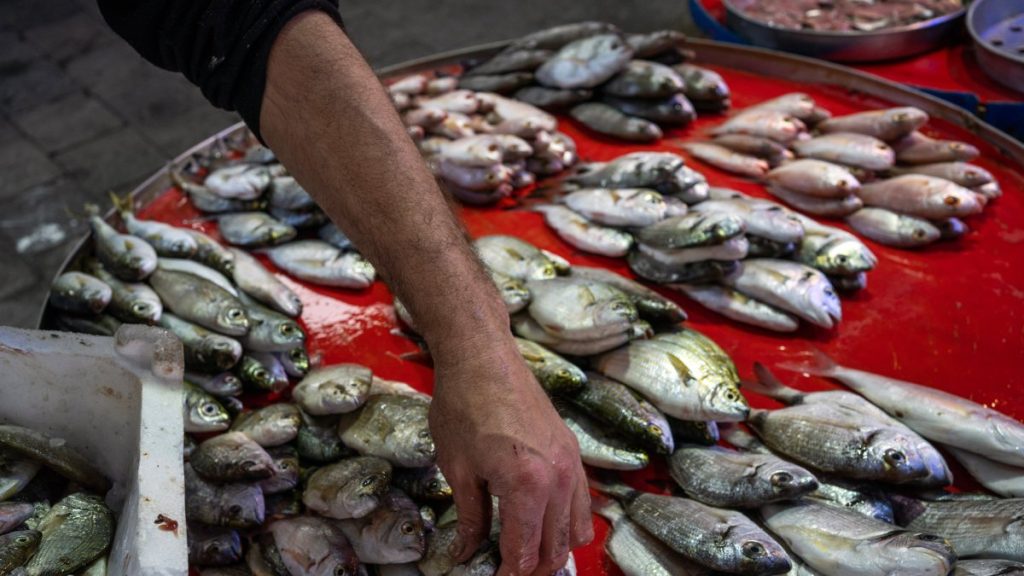A new research has detected microplastics at varying rates in the digestive system of 11 commercial fish in the Gulf of Izmir and that there may be more microplastics near the water surface than at the bottom.
Scientists from the university examined microplastics in fish such as mackerel, red mullet, sea bream, sea bream, tern, sea bass, coral, mullet, horse mackerel, sardine, mackerel and shad in Gulf of Izmir, western Türkiye.
Within the scope of the study, microplastics were detected in the digestive system of the fish examined in amounts ranging in size from 101 to 4,901 micrometers.
While microplastics were detected in 55% of the mullet fish examined, microplastics were found in 50% of mackerel, 42% of mackerel, 42% of horse mackerel, 41% of bream, 39% of sardines, 38% of shad, 36% of red mullet, 33% of corals, 30% of sea bass, 29% of swallows and 17% of murrel.
When microplastics were sorted by color, black was the most common color at 64.9%, while reds were 10.4%, blues at 9.1%, greens at 7.8%, white microplastics were 6.5% and transparent microplastics were found at 1.3%.
Evaluating the results of the study to Anadolu Agency (AA), Kenan Gedik, an academic and the director of Recep Tayyip Erdoğan University Vocational School of Technical Sciences, said that all plastics such as food packages, bags, packaged drinks, disposable materials, various kitchen utensils, toys and fabrics that everyone sees around them in daily life constitute the source of microplastics.
Approximately 20 million tons of plastic waste are released into the seas every year worldwide, most of which are single-use plastics. “According to estimates, plastic production is expected to double by 2040 and plastic pollution in the seas is expected to increase in parallel. Therefore, plastic pollution threatens marine life and ecosystems on a global scale and increases ecological risks.” he added.
Gulf, microplastics
Gedik said that they wanted to take a photo of the Gulf of Izmir, which has recently come to the agenda with the environmental disaster that caused fish deaths due to the discharge of domestic and industrial wastewater without treatment, in terms of microplastics and that they investigated the accumulation of microplastics in fish caught in the region and their properties.
Gedik added that they examined commercial fish species living in different habitats on the seabed (demersal), above the bottom (benthopelagic) and near the surface (pelagic) to fully reflect the Gulf of Izmir during their studies and that they detected different amounts of microplastics in fish species.
“Compared to demersal fish, more microplastics accumulate in pelagic fish species. When we looked at the properties of the microplastics we detected, we saw that 50.6% were fragments and 49.4% were fibers. In addition, we determined that the detected microplastics were in seven different polymer types and the most dominant type of these polymers was polyethylene,” Gedik said.
“The most microplastics were detected in mullet, a benthopelagic species and mackerel, a pelagic species, while the least microplastics were detected in mackerel, a demersal fish species. This result showed us that more microplastics may be near the water surface than at the bottom. When we looked at the characteristics of microplastics, we saw that their sources were dominated by fibers and food packaging released from washing synthetic textile products, which enter the marine environment through urban discharges and surface runoff,” he said.
Pointing out that fish can consume microplastics in the water by mistaking them for food, Gedik said that these microplastics can block the digestive tracts of fish and due to the damage to their digestive systems, there may be problems in nutrient absorption.
Mentioning that microplastics can act as carriers for pollutants attached to their surfaces, Gedik said, “Thus, other pollutants can be carried into the body of living things on microplastics. Microplastics can create a feeling of satiety in fish larvae due to their size and since there is not enough nutrition, which is very important for larvae, their growth and participation in stocks may be negatively affected.”
“Since this situation will cause imbalances in the food chain in the future, the process may affect the entire marine ecosystem,” he added.
Gedik stated that humans are also exposed to microplastics found in fish through the food chain.
Pointing to the danger of chemicals such as phthalates or bisphenol A (BPA) added to plastics during the production phase, Gedik said that microplastics can cause changes in liver function and insulin resistance, the reproductive system, brain function and developmental disorders in babies in the womb.


